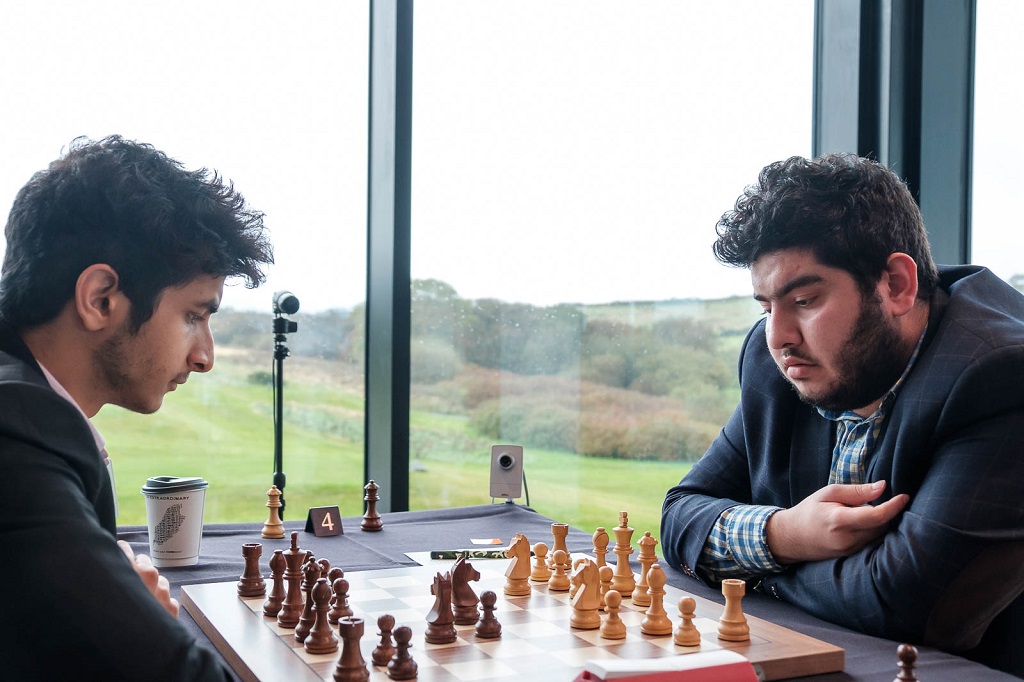


Chess News



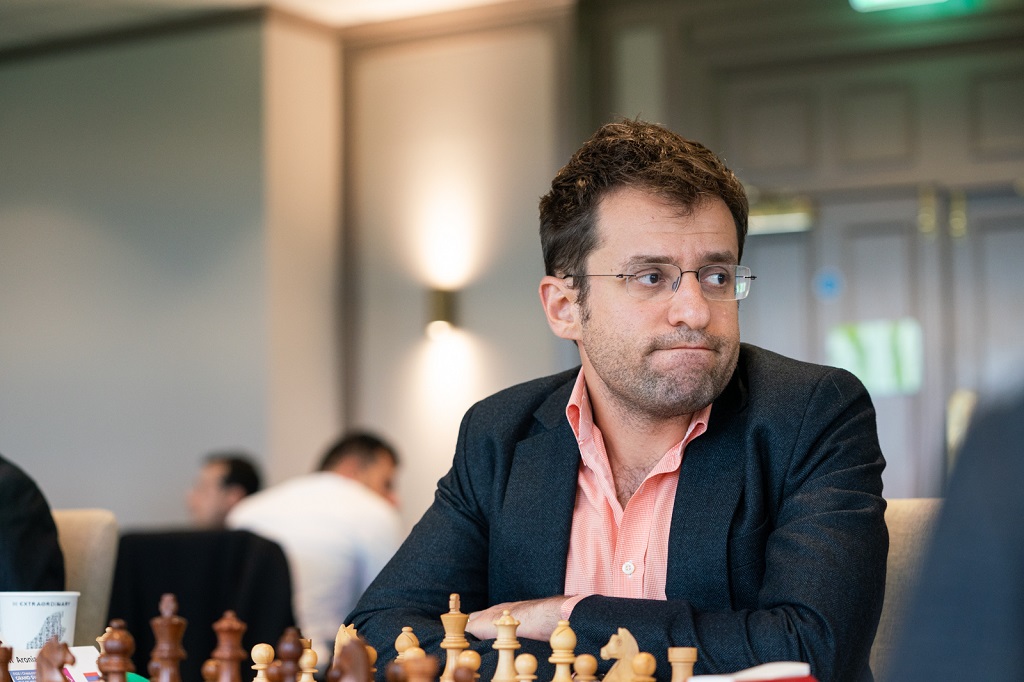
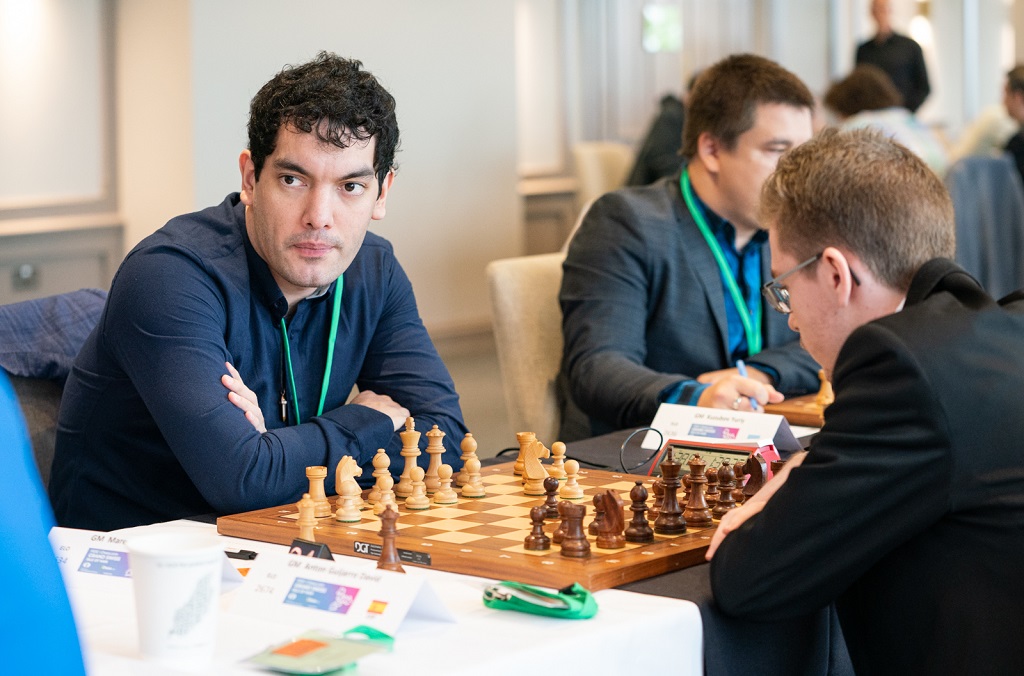
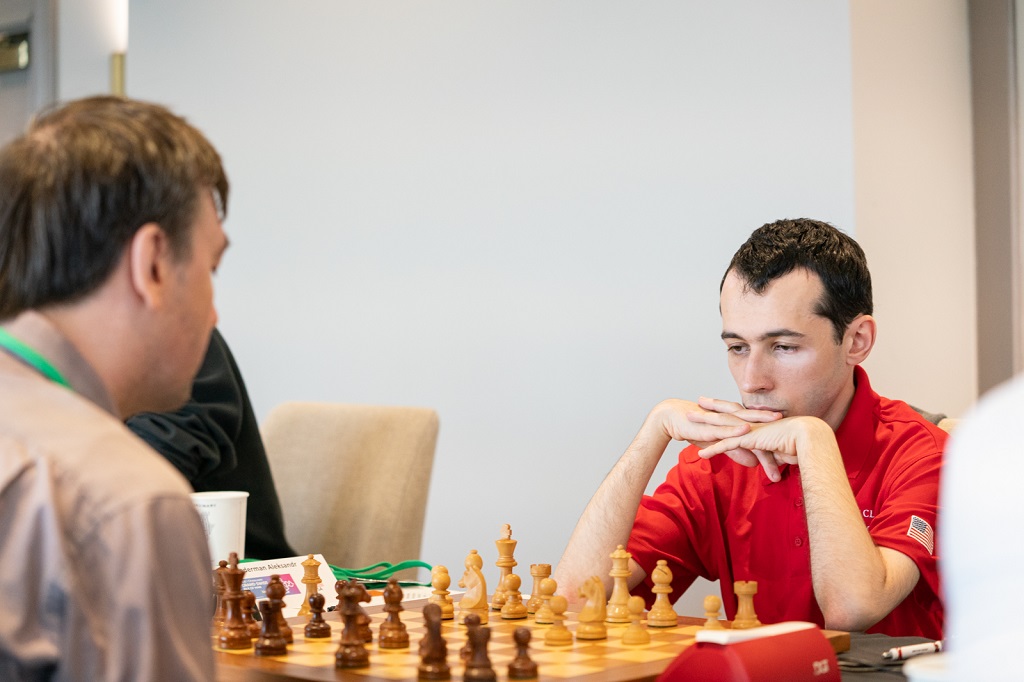

The FIDE chess.com Grand Swiss is an eleven-round event that serves as qualifier to the 2020 Candidates Tournament. It takes place from the 10th to the 21st of October, with a rest day on the 16th. You can find more info here.
While most eyes were paying close attention to board seven, where Vladislav Kovalev was about to stop Magnus Carlsen's 93-game undefeated streak in classical chess, Parham Maghsoodloo and Luke McShane were in the process of outplaying their round four rivals to catch up with the tournament's co-leaders. In the end, the world champion saved the half point, while Vidit and Adhiban had to concede defeat against the now co-leaders in Douglas.
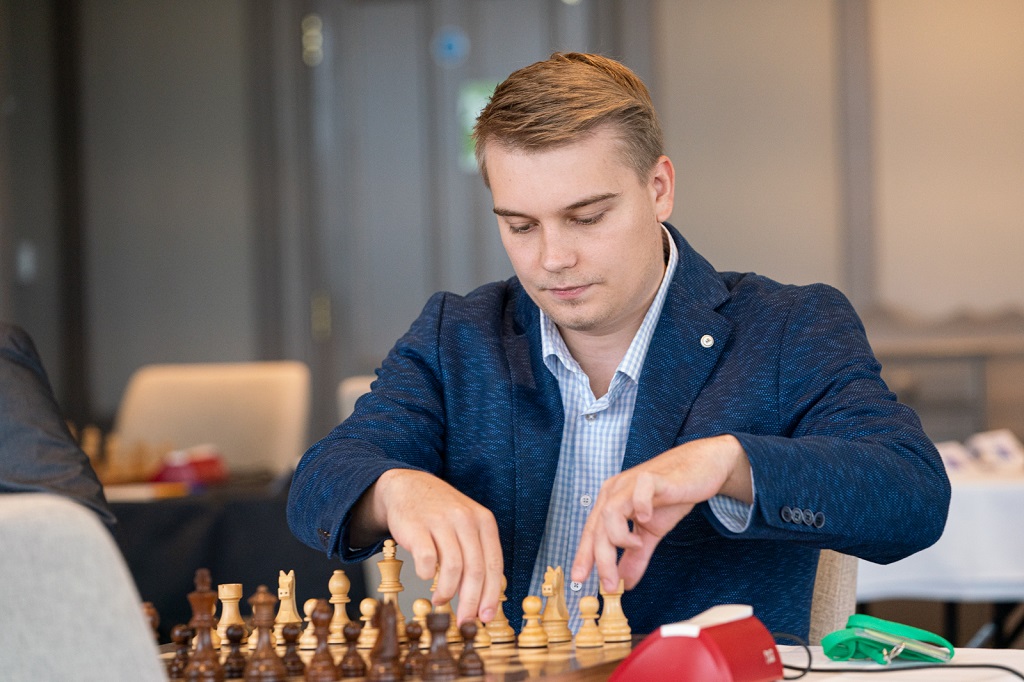
Vladislav Kovalev getting ready to face the champ | Photo: Maria Emelianova / chess.com
Maghsoodloo was sitting on board four, playing White against an opponent that had beaten him twice this year — Vidit had scored wins over the current junior world champion both in classical and blitz at the Biel Tournament back in July. Maghsoodloo was well-aware of this fact, which prompted him to be extra careful in the handling of a superior opposite-coloured bishops endgame. But things started to go south for Vidit long before, on move 16:
According to Maghsoodloo, Black needed to transfer his queen to h4 instead of opting for 16...♛g5. At this point, the Iranian had made up his mind about castling long, so 17.f3 was a move that only facilitated this plan. Notice that after 16...♛h4, the f-pawn cannot move, — in fact the computer suggests short castle as the best way to continue.
After the advance of the f-pawn, Vidit picked up on his rival's intentions and spent almost eleven minutes on 17...♜f6. But Maghsoodloo's mind was set on playing for the initiative on the kingside and went forward with 18.h4 immediately. Soon enough, the white king was safely guarded on the queenside, which meant Maghsoodloo could readily target Black's weaknesses. Vidit kept looking for tactical tricks, and the best he found was to go into an opposite-coloured bishops endgame a pawn down:
Maghsoodloo could have played 37.♗d6+ here, immediately capturing the c-pawn with the bishop, but precisely calculated that marching his king up the board starting with 37.♔c4 was also winning. With his monarch already on c7 and his connected passers a little ahead in the pawn race, the Iranian grandmaster went on to get the full point.
Curiously, during the post-game interview, Danny King asked Maghsoodloo about his trademark 'lucky vest', and the Iranian explained that the organizers had banned the garment as it did not meet the dress code requirements. Maghsoodloo then quipped that if he gets to become world champion — an ambition he openly shared in the past — he will certainly change the rules that impede him from wearing his favourite article of clothing.
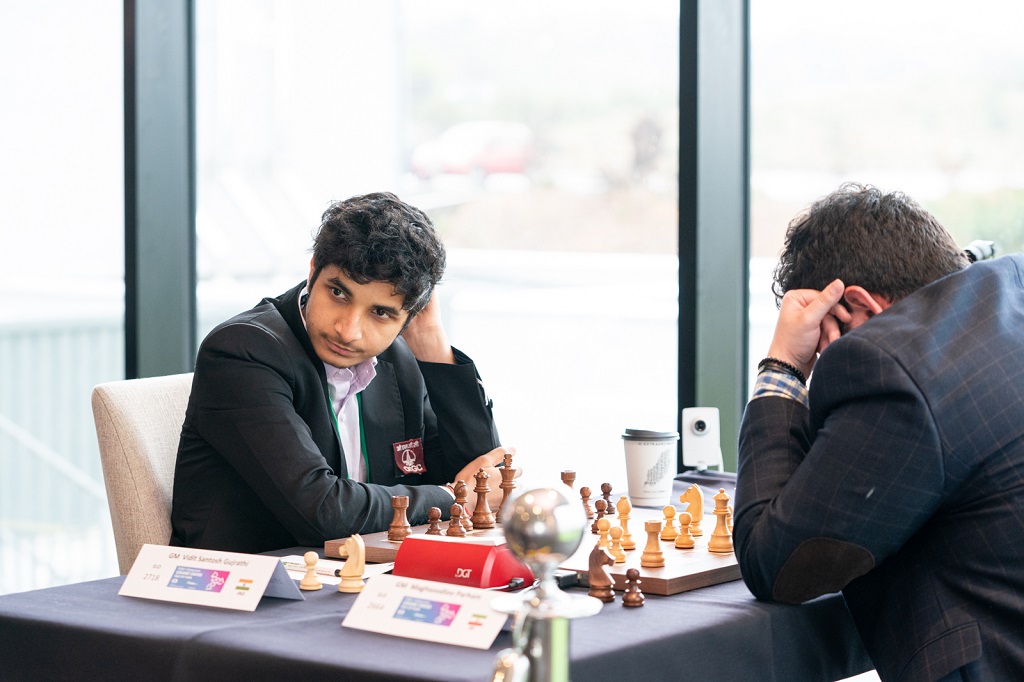
Vidit will try to bounce back against Robert Hovhannisyan in round five | Photo: Maria Emelianova / chess.com
In the meantime, McShane was getting the better of another Indian star two boards down. Adhiban had proposed a Sicilian Defence and the Englishman had decided on a Maroczy bind setup as his best approach. Already with a slightly superior position, McShane gave up a pawn in order to further weaken Black's structure:
White played 19.e5, allowing Black to capture his central pawn with 19...♞xe5 20.♘xe5 ♝xe5. The idea was to get a strong centralized knight with 21.♘e4 while provoking the exchange of dark-squared bishops — there followed 21...♝xb2 22.♕xb2 and the black king was left with little protection around his position.
Adhiban found nothing better than 22...d5 and the knights were traded with 23.g4 dxe4 24.gxh5. This sequence allowed White to continue weakening Black's structure — 24...e5 25.hxg6 hxg6. McShane then swiftly invaded his opponent's camp through the open files and diagonals. Resignation came on move 37, when the Englishman simplified into a winning king and pawns endgame.
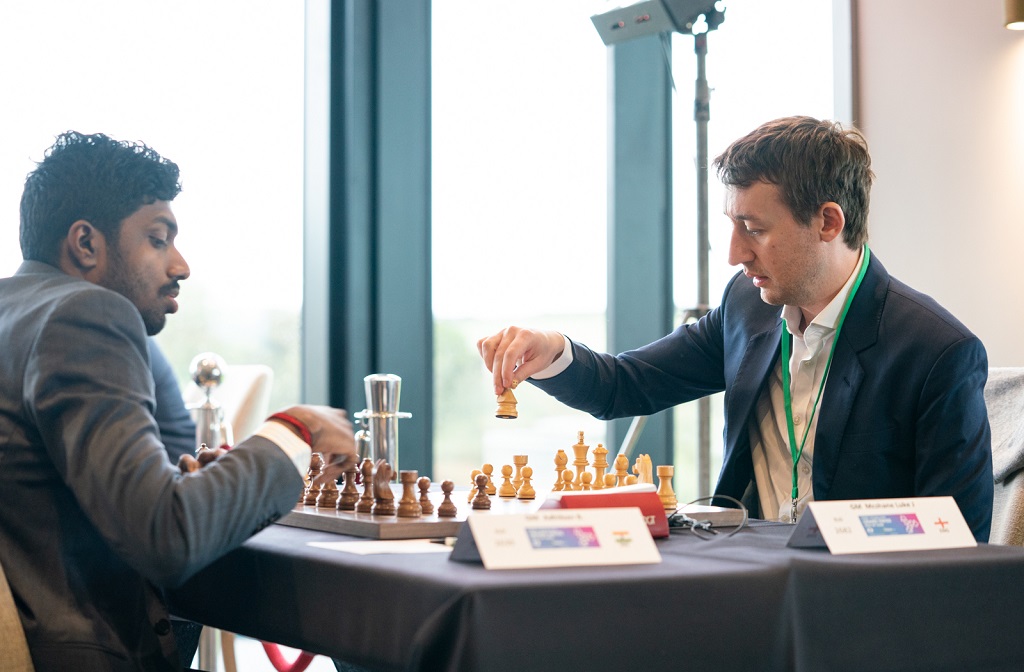
Adhiban Baskaran v Luke McShane | Photo: Maria Emelianova / chess.com
The story of the day did not develop on board one — where Fabiano Caruana was pressing but in the end could not keep his perfect score against Wang Hao — but six boards 'below', where Vladislav Kovalev came within an inch of bringing Magnus Carlsen's undefeated streak to a halt after 438 days of not losing a single classical game.
The players followed ten moves of a line the world champion himself had used with Black to beat Etienne Bacrot two years ago. In the early middlegame, it was clear that Carlsen had not managed to equalize, and on move 19 he made a mistake that left him in a rather woeful situation:
White's passed d-pawn is quite bothersome, and at this point Black needed to acknowledge this fact and play 19...♞a5, planning to take the knight to b7, where it would fulfill the defensive task better than from f5. Instead, after 19...♞e7, White centralized his queen and took control over the position with 20.d6 ♞f5 21.♕b3+ ♚h8 22.♕d5.
Black was under a lot of pressure, but things only got worse in the following moves:
Kovalev had just gone for an exchange of the minor pieces, correctly assessing that this position is clearly favourable for White. Also — and this is a key factor — he was entering extreme time trouble here.
At this point, White needs to realize that he needs to slowly increase the pressure, combining threats while Black is tied down defending against a potential promotion of the d-pawn. But when you are facing one of the strongest players of all time and your clock is dangerously ticking down, ghosts begin to appear. As it turned out, shortly after the time control, Carlsen managed to simplify into a drawn rook endgame, with White's extra a-pawn unable to create any winning chances.
A visibly baffled Kovalev could not believe his eyes. He had missed a golden chance to take down the strongest player in the world — and in the midst of a historic unbeaten streak no less! It must be noted, nevertheless, that the Belarusian grandmaster came from winning his round three game only after a whopping 151 moves, when he finally got the better of IM David Gavrilescu from a theoretically drawn queen endgame.

World champion Magnus Carlsen | Photo: Maria Emelianova / chess.com
While Nikita Vitiugov could not make the most of a favourable endgame against Ivan Cheparinov and thus remained in the sixteen-player chasing pack, other (new) members of this group are now a half point behind the co-leaders after winning their round four encounters. Among these, we find some of the pre-tournament favourites: Sergey Karjakin, Levon Aronian and Radoslaw Wojtaszek all won fine positional games with White to enter Monday's round with a 3 out of 4 score.
Other players that scored wins to join said group are Matthias Bluebaum, Boris Gelfand, Aleksandr Lenderman, David Anton, Yuriy Kryvoruchko, Alexei Shirov and Aleksey Dreev. You can replay all these players' round four wins in the viewer below.
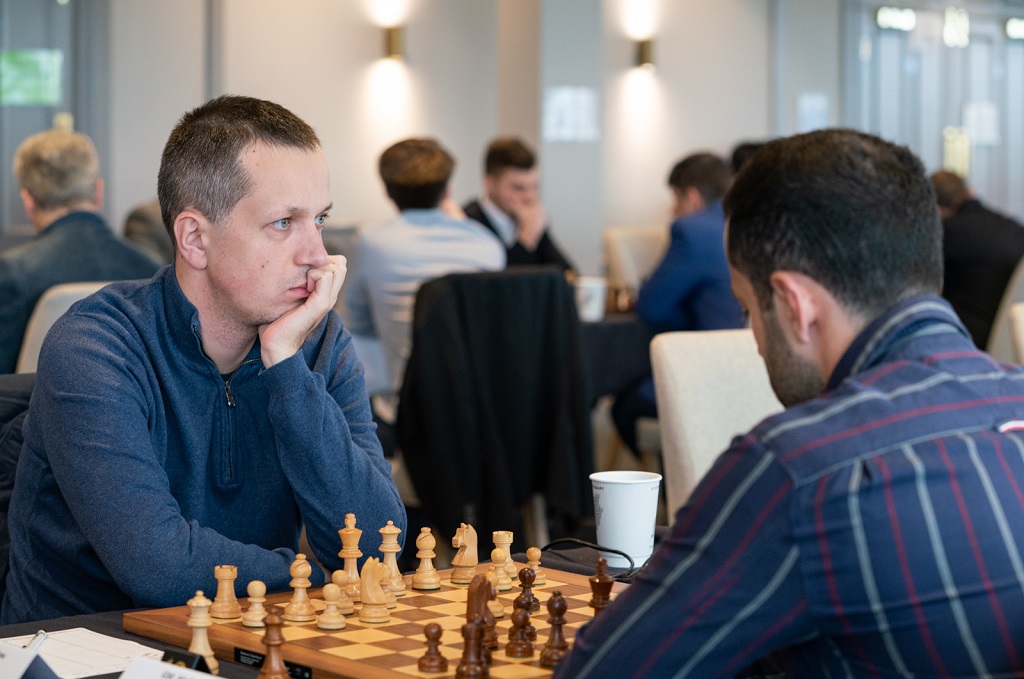
Radoslaw Wojtaszek will face Vladimir Fedoseev on Monday | Photo: Maria Emelianova / chess.com
Commentary by GM Daniel King and IM Anna Rudolf
| Bo. | Name | Pts. | Result | Pts. | Name |
| 1 | McShane Luke J | 3½ | 3½ | Caruana Fabiano | |
| 2 | Wang Hao | 3½ | 3½ | Maghsoodloo Parham | |
| 3 | Anton Guijarro David | 3 | 3 | Karjakin Sergey | |
| 4 | Grischuk Alexander | 3 | 3 | Cheparinov Ivan | |
| 5 | Kryvoruchko Yuriy | 3 | 3 | Aronian Levon | |
| 6 | Fedoseev Vladimir | 3 | 3 | Wojtaszek Radoslaw | |
| 7 | Vitiugov Nikita | 3 | 3 | Lenderman Aleksandr | |
| 8 | Shirov Alexei | 3 | 3 | Sargissian Gabriel | |
| 9 | Dreev Aleksey | 3 | 3 | Gelfand Boris | |
| 10 | Bluebaum Matthias | 3 | 3 | Alekseenko Kirill | |
| 11 | Carlsen Magnus | 2½ | 2½ | Ganguly Surya Shekhar | |
| 12 | Yu Yangyi | 2½ | 2½ | Kovalev Vladislav | |
| 13 | Harikrishna Pentala | 2½ | 2½ | Sarana Alexey | |
| 14 | Artemiev Vladislav | 2½ | 2½ | Kasimdzhanov Rustam | |
| 15 | Papaioannou Ioannis | 2½ | 2½ | Nakamura Hikaru | |
| 16 | Mamedov Rauf | 2½ | 2½ | Svidler Peter | |
| 17 | Lupulescu Constantin | 2½ | 2½ | Bu Xiangzhi | |
| 18 | Vidit Santosh Gujrathi | 2½ | 2½ | Hovhannisyan Robert | |
| 19 | Riazantsev Alexander | 2½ | 2½ | Matlakov Maxim | |
| 20 | Adhiban B. | 2½ | 2½ | Howell David W L |
All games available at Live.Chessbase.com